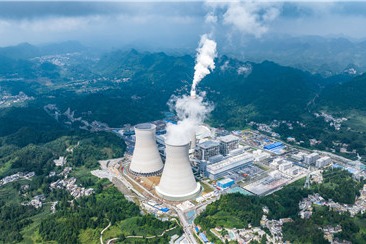Stricter scrutiny for capital markets
Latest guideline encourages long-term investment to create greater stability


China has recently released a guideline to ensure the high-quality development of its capital markets, with particular emphasis on strict scrutiny of initial public offerings, strengthened trading regulation and the promotion of long-term capital investment.
With the intention of deepening capital market reforms, China aims to create a more transparent, efficient and investor-friendly environment, and foster a robust and well-regulated financial system that can better underpin sustainable economic growth, officials and experts said.
In mid-April, the State Council, China's Cabinet, issued a guideline to strengthen regulation and risk prevention, and promote the high-quality development of capital markets. It's the third guideline released by the State Council concerning capital market reforms and strategic planning, following similar releases in 2004 and 2014.
The 2004 guideline focused on the issue of dual-class share structures and introduced reform of shareholding separation, while in 2014, the second guideline was released focusing on promoting technological innovation in capital markets, said Yang Delong, chief economist at First Seafront Fund.
The most recent guideline builds upon the previous reforms and provides a comprehensive plan for the high-quality development of China's capital markets. It demonstrates the government's commitment to continuously improving and refining the regulatory framework to meet the evolving needs of the market, Yang added.
In particular, the stock market volatility witnessed since August of last year has revealed certain shortcomings in the existing system, said Wu Qing, chairman of the China Securities Regulatory Commission, stressing that the significance of identifying and rectifying these issues has been brought to the fore.
The stable operation of capital markets serves as a significant indicator of market maturity and healthy development. It plays a crucial role in promoting long-term investment and overall economic growth, experts said.
The crucial role of initial public offerings in shaping capital markets and safeguarding investor interests has been emphasized in the guideline, which highlights the need to reinforce the primary responsibility of issuers and the monitoring role of intermediary institutions. It also introduces the establishment of a blacklist system for intermediaries.
The guideline places significant emphasis on the accountability of issuers and intermediary institutions during the listing process. They will be held primarily responsible for the accuracy, authenticity and comprehensiveness of the information they provide.
Shortly after the release of the guideline, the CSRC rolled out measures to enhance the quality of companies seeking listing by increasing the frequency of random sampling and on-site inspections.
The regulatory body will inspect a minimum of 25 percent of first-time issuers, a substantial increase from the previous minimum of 5 percent. This move is expected to significantly enhance the scrutiny and oversight of initial public offerings.
The latest guideline has introduced specific regulatory measures for algorithmic trading, also known as automated or program trading. It's the first time algorithmic trading regulation has been officially addressed in the country. The main objective of the regulation is to promote standardized development rather than imposing limitations.
The market value of algorithmic trading investor holdings accounts for around 5 percent of the total market capitalization of A-shares, and the trading volume accounts for some 29 percent. As of the end of last year, there were 119,000 reported algorithmic trading accounts in the market, according to data from the CSRC.
Compared to some mature markets, where algorithmic trading accounts for over 50 percent of trading volume, China's algorithmic trading is still at a relatively early stage.
The integration of algorithmic trading into a rational and legitimate regulatory framework has the potential to enhance market transparency, reduce opaque practices and foster fair competition, said Fu Jingtao, A-share strategy chief analyst at Shenwan Hongyuan Securities.
This move aims to promote the standardized development of algorithmic trading, empowering investors to make more informed trading decisions and stimulating the healthy growth of financial markets, Fu said.
Algorithmic trading, particularly high-frequency trading, possesses distinct technological, informational and speed advantages that can lead to certain challenges, including strategy convergence and trading resonance, which may amplify market volatility, Fu added.
The regulation of high-frequency trading is another crucial aspect covered in the guideline.
Stock exchanges in China employ certain criteria to screen high-frequency trading activities. These criteria include a maximum declaration rate of at least 300 orders per second or a daily maximum of 20,000 orders.
Based on these screening results, the number of high-frequency trading accounts is relatively limited, but their trading volumes are substantial, accounting for approximately 60 percent of the total volume of algorithmic trading.
Internationally, high-frequency trading has been a focal point for regulatory authorities in various countries. Japan has implemented mandatory registration for high-frequency trading, the European Union has introduced differential fees for the practice, and in the United States, engaging in manipulative practices through the use of algorithmic trading is considered market manipulation and subject to penalties.
The guideline has bolstered the oversight of high-frequency trading and aligns with the reality of China's market, where there is a significant proportion of individual investors, and aims to mitigate the risks associated with significant market fluctuations to a certain extent, said Tian Lihui, director of the Institute of Finance and Development at Nankai University.
He added that regulators recognize the need to strike a balance between allowing the practice and mitigating potential risks. By implementing targeted regulations, authorities seek to manage and control the negative effects associated with high-frequency trading while ensuring its overall safety and stability, Tian said.
The importance of establishing an environment conducive to long-term investment has been highlighted in the guideline. By nurturing a market ecosystem that rewards and supports patient capital, authorities aim to encourage investors to adopt a long-term perspective when making investment decisions, experts said.
As of the end of last year, professional institutional investors held a market capitalization of A-shares worth 16 trillion yuan ($2.21 trillion), a figure that has more than doubled over the past five years. Their ownership ratio increased from 17 percent to 23 percent in the same period, said Shen Bing, director general of the department of fund and intermediary supervision at the CSRC.
Among them, mutual funds held a market capitalization of A-shares worth 5.1 trillion yuan, with their ownership ratio rising from 4 percent to 7.3 percent. They have now become the largest professional institutional investor in the A-share market, Shen added.
Despite these positive developments, challenges remain. The current capital market still faces a shortage of long-term funds, which hinders the formation of a policy environment conducive to "patient capital" investment. The proportion of equity products in mutual fund portfolios remains relatively low, limiting their market-leading capabilities, Shen said.
The introduction of long-term capital is essential to foster stability in the capital market. Long-term investors provide stability by holding assets for extended periods, reducing market volatility and promoting sustainable growth, said Xu Hongcai, deputy director of the China Association of Policy Science's Economic Policy Committee.
As the largest institutional investors, mutual funds play a significant role in driving the market. To further bolster their contribution, it's imperative to increase the proportion of equity funds within the overall mutual fund industry, Xu added.
wangkeju@chinadaily.com.cn
- Ten photos from across China: Aug 22 - 28
- Romance in the cosmos of ancient Chinese poetry
- China's anti-fascist war to be retold through words of Western correspondents
- Fuxing Island to host 2025 Shanghai Urban Space Art Season
- Flight ban call after drones collide above iconic Shanghai skyscraper
- Officer shines as a leader who treats his soldiers like an elder brother




































